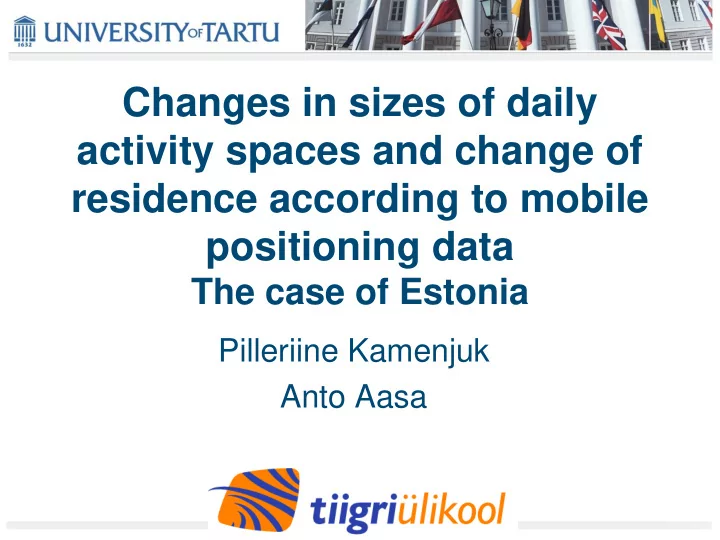

Changes in sizes of daily activity spaces and change of residence according to mobile positioning data The case of Estonia Pilleriine Kamenjuk Anto Aasa
Importance of the subject • Widen the concept of migration and travel behaviour. • Longitudinal data – new analysis on new levels. • Differences in spatial mobility.
Migration • Change of residence from one area to another crossing municipal or country borders. • More dynamic approach needed. • Migration as everyday practice (Halfacree, 2012; Ho & Hatfield, 2011). • Home as a centre of gravity (Hägerstrand, 1970; Roseman, 1971).
Activity spaces • Activity space approach (Colledge & Stimson, 1997; Newsome, 1998). • Everyday activities and individual movement between them – home, work, leisure. • Interconnectedness of change of residence and everyday mobility.
Aim of the study • Develop a methodology. • Give an estimation on the size of actual activity spaces of Estonians (year 2011). • Research questions: – Does the activity space of movers differ from those who stayed put? How does it vary with different socio- demographic groups? Settlemet hierarchy? – Does the change in residence affect the size of the activity space?
Data and method (1) • Passive mobile positioning data, anchor point model (Ahas et al., 2010). • Change in residence – permanent change in home anchor point. – Criterias: distance, character of the move.
Data and method (2) • Estimation of the sizes of activity spaces. – Actual, regularly visited (measured/positioned) locations. – Size of the activity space – activity ellipses (standard deviational ellipse – ArcMap), buffers. – Socio-demographic variables, levels of settlement hierarchy. • Statistical analysis: Kruskal- Wallis, Duncan’s multiple range test.
1 anchor point activity spaces
2 anchor points activity spaces
3 and more anchor points activity spaces
Activity spaces of … • movers • non-movers • Mean 1715 km 2 , • Mean 706 km 2 , median median 409 km 2 . 109 km 2 . • Men (23%) > women • Men (47%) > women • Estonians (51%) > • Estonians (44%) > Russians Russians • With age the size of activity space decreased. • Settlement hierarchy – towns and their hinterland, rural areas.
Change in residence and the size of activity spaces • Change in residence had no impact on the size of activity spaces. • Particular directions: – City and its proximate hinterland (change of home anchor point less than 30 km). – Distant hinterland (30 – 100 km).
Conclusions • Alternative method for measuring migration. Mapping interconnections between change of residence and everyday space usage. – Differences in sizes of activity spaces. – Movers had overall bigger activity spaces than non- movers. – Change of residence had no impact on the size of activity space. • Critics: – Ellipses are sensitive to locations of activities in space and distances is there any better approach? – Add more variables to the ellipses and buffers . – Add more socio-demographic variables.
Thank you! pillerii@ut.ee Supported by the Tiger University Program of the Information Technology Foundation for Education
Recommend
More recommend